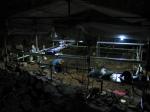Summary (English)
The main objective of the 2015 campaign was to complete the excavation of layer US4 corresponding with the Upper Paleolithic horizon already explored in six quadrants (Q15,R15,Q16, P16, Q17, P17). In 2014, its removal had revealed a paleo-surface with a very complicated morphology (roof of US5), with vertical excavations and rills, as well as clear traces of the combustion of sediments and several stones. This paleo-surface was interpreted as resulting from the large-scale runoff of waters from outside the cavity, in the presence of a surface sloping towards the interior. It was on this paleo-surface, that was in the process of being levelled by clay material carried by the water runoff, that the Paleoliths settled, leaving behind worked stone and a few faunal remains, spread within the stratigraphic layer but with a greater horizontal concentration in quadrants Q15, Q16 and P16. No clear structures relating to the Paleolithic occupation were documented, with the exception of a curved alignment of stones between quadrants P16 and P17. Some of the stones appeared burnt and although there were no traces of charcoal, it is suggested these remains represent traces of a hearth.
The excavation of US4 in quadrants Q18 and P18 revealed more of the paleo-surface with the same characteristics, in which there were two post-holes filled by sediment from US 4, certainly datable to the Upper Paleolithic horizon. This horizon has been dated from a charcoal sample taken in 2014 and tested at the CEDAD laboratory in Lecce. The result fell within the full Pleistocene period ( LTL15195A- 13615 +/-75 BP, 14750-14210 BC cal.2s.), in the isotopic 2 stage, probably at the beginning of the Late Glacial Maximum. The typology of the lithic industry seemed attributable to the evolved final Epigravettian period (study ongoing).
Once a photo-piano was made of the entire paleo-surface (roof of the underlying US5), excavation of the new layer was carried out in quadrants Q15 and R15. This was constituted by a dark yellowish-brown sandy-clay sediment, without a calcareous skeleton or any lithic finds (the rare finds came from US 4 above), but rich in micro-mammals and to a lesser degree bird remains. The excavation stopped at a new layer, constituted by sediment similar in characteristics to the one above, but compacted and containing calcareous gravel.
- Mauro Calattini - Università degli Studi di Siena, Dipartimento di Archeologia e Storia delle Arti, Sezione di Preistoria
- Attilio Galiberti - Università degli Studi di Siena, Dipartimento di Archeologia e Storia delle Arti
Director
Team
- Studenti del Dipartimento di Scienze Storiche e dei Beni Culturali e membri dell’Associazione Archeologica Piombinese
Research Body
- Università degli Studi di Siena






![Download [PDF]](/excavation/skins/fasti/images/results/download_sml.png)